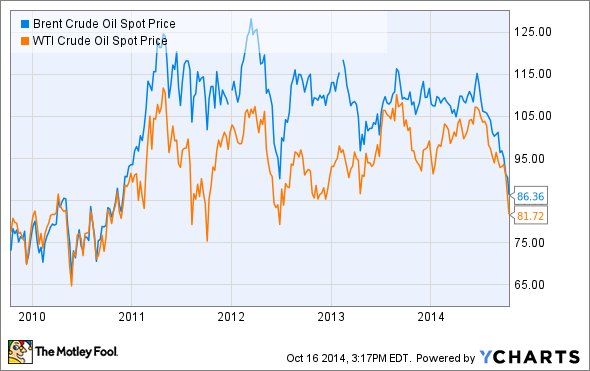Oil prices recently plunged to the lowest point in more than four years. Abundant supplies and tepid demand have the world awash in oil. Saber rattling in the Middle East can no longer be heard over the roaring sound of American oil wells that are just gushing with oil. It's a situation few predicted, and now even OPEC suggests that low oil prices could be here to stay for a while. The question that remains is how low is low?
A cloudy crystal ball
While oil prices have been relatively stable for the past few years, it has still been a bumpy ride. We can see this in the following chart, which tracks the global oil benchmark Brent, along with the U.S. benchmark WTI.
Brent Crude Oil Spot Price data by YCharts
Generally speaking, Brent has traded between $105 and $115 while WTI has been between $95 and $105. Because of this, most oil price forecasts have oil staying between those prices, though the forecasts do hint at lower prices given the U.S. shale boom. For example, the U.S. Energy Information Administration forecasts Brent to average $104.42 this year and $101.67 next year. Meanwhile, it sees WTI averaging $97.72 this year and $94.53 next year.
That being said, forecasting oil prices is more art than exact science as it comes with a pretty large margin for error. We see this in the following chart, which shows the possible range of future oil prices over the next year.

Source: EIA.
This forecast suggests with 95% confidence that WTI oil prices won't fall below about $60 nor rise above $125 over the next year based on what the oil markets see today. That's not to say oil can't fall below $60, but that it's highly improbable based on what the market sees today.
In fact, most Wall Street analysts see oil prices having a downside as low as $70 per barrel if OPEC doesn't begin to cut production. However, that doesn't mean oil will get down that low, nor does it mean that oil prices will stay there for very long.
The end of drill, baby, drill?
What we do know is that oil prices can't fall too far before making a dramatic impact on the oil market. The relative stability over the past few years has really encouraged oil producers not affiliated with OPEC to drill, as it has been quite profitable to do so. This is because the breakeven price for drilling most oil wells around the world is less than $80 per barrel, as we see in the slides of a recent Chevron (CVX 1.04%) investor presentation.

Source: Chevron Corporation Investor Presentation.
While most producers can make a tidy profit with oil prices over $100 per barrel, some marginal sources need oil above that price to produce profits. Because of this these projects likely won't get the green light with oil prices in a tailspin. Further, once oil prices get below $75 per barrel and stay there for a while it would be right at the breakeven point of most sources of oil around the world outside of OPEC nations.
That price would force oil companies like Chevron to rethink investments to drill new wells. This is especially true for deepwater oil sources and U.S. tight oil sources like shale, which have higher costs. By cutting investments to drill new wells it would cause oil supplies to slowly decline. That's because the production from oil wells naturally declines as the pressure is relieved and the wells begin to deplete. As we see in the next slide, declining base production requires investments to drill new wells to fill the gap between declining supply and rising demand.

Source: Chevron Energy Corporation Investor Presentation.
While the world is awash in oil today, that might not be the case if producers cut investments that were intended to bring new oil supplies online. Without those new supplies the natural decline rate of oil wells will quickly eat into production rates, which would certainly backstop oil prices.
So, how low could oil prices go?
Oil prices somewhere around $70-$75 per barrel would really force producers to make cuts to curb production. That's not to say oil prices couldn't fall further, but that would only cause the cuts to be more dramatic. Moreover, at some point OPEC will need to cut its own production as many of its members had been banking on oil prices staying over $100 per barrel to support their budgets. So could oil prices get below $70 per barrel? Sure, with enough panic any price is possible. But, longer term oil prices need to be well above the breakeven price of production for producers to keep drilling, and that price is at least $80 per barrel and likely closer to $100.





